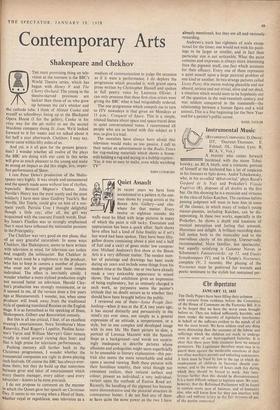Instrumental Music
(RECORDING COMPANIES: D, Decca ; DT, Ducretet-Thomson; F, Felsted; OL. Oiseau Lyre; R, RCA; V, Vox.)
A PIANIST who comes forward
burdened with the name Tchai- kowsky, an RCA blurb, and a romantic portrait of himself at the keyboard has a lot of suspicion in his listeners to fight down. Andre Tchaikowsky, who, in his so-called 'debut-recital,' plays Ravel's Gaspard de la Nuit and Prokofiev's Visions Fugitives (R), disposes of all doubts in the first bar. On this showing he is a musician and virtuoso in the class of Julius Katchen. The cautious before passing judgment will want to hear him in some of the classics, in which many of today's young master-pianists, including Katchen, can be dis- appointing. In these two works, especially in the Prokofiev, he shows a depth and keenness of musical perception and feeling that astonish, illuminate and delight. A brilliant recording does full justice both to the musicality and to the marvellous clarity of his playing. Unreservedly recommended. More familiar, less spectacular, but equally satisfying is Guiomar Novws in Schumann's Fantasiestiicke, op 12, and Etudes Symphoniques (V), and in Chopin's Nocturnes, complete (V, 2 records). Her playing of the Nocturnes must be preferred for warmth and poetic sentiment to the stylish but restrained per-
formance of them by Peter Katin (D), the second volume of which is now issued. On the Schumann record she performs the remarkable feat of impos- ing a feminine style on the Etudes Symphoniques, disguising everything of technical display or pianistic effort beneath the flow of pure lyrical melody, realised in piano tone of the utmost beauty. Also a five-star record. Schumann has been generously treated lately by Vox, who have now added his Piano Trios Nos. 1 and 3 to their earlier Quintet and Quartet. Despite some lovely melodies in No. 3 the Trios do not reach the same level as the more famous works, and the less satisfactory nature of the medium also is apparent, either in the performance by the Trio di Bolzano or in the recording—possibly in both. Another of the Vox pianists, Friedrich Wiihrer, joins Joseph Schuster in two cello sonatas—Brahms in E minor and Strauss, op. 6. They are a finely balanced partnership, and bring to both works a springiness and ease of style and technique that rid them of all heaviness of tone or heavy- handedness of romantic gesture.
The latest addition to the Barchet Quartet's excellent Mozart series is the Hunt Quartet, bocked by the E flat, K.428 (V). Without the enchantments of phrase of their best perfor- mances, these are stylish and pleasing. A rarer contribution to recorded Mozartiana is the fifteen one-movement Church Sonatas for chamber orchestra and organ (not a solo part), complete on one disc (V). Despite one or two very lovely movements, this is only for the insatiable Mozartian. A collection of four wind quintets by J. C. Bach (OL) reveals nothing of the genius discovered in 'one or two of the symphonies by him issued by this company, but is the ideal sort of thing to put on as an accompaniment to dining alone. Spohr's Octet in E (D), finely played by the Vienna Octet, strikes a similar level in a more romantic idiom, pleasing but too facile to
reward attentive listening for very long. The Octet on the other side by the modern Belgian composer Marcel Poot is eclectic, skilfully written and undistinguished. Other chamber music for wind instruments includes an issue of .Brahms's Horn Trio (D) that is intended partly as a demonstration of a particular make of French horn, the distinctive tone of which may for some be an objection to it. Mozart's Bassoon Concerto K.191 is on the other side—with piano accompani- ment, which is not satisfactory. A more successful transcription is of one of his violin sonatas, for a flute and piano recital (F) that includes also sonatas by Clementi and the American Walter Piston, and a Divertimento by Francaix. This is an interesting and enjoyable record, exactly the right quantity and variety to hear the flute in. Finally, for the lively-minded only, a new experience in sound, not exactly instrumental, is offered by two Unesco records of Musique Con- crete (DT), which are fascinating to hear a time or two, though the fascination seems unlikely to grow into lasting musical satisfaction.
COLIN MASON



































 Previous page
Previous page